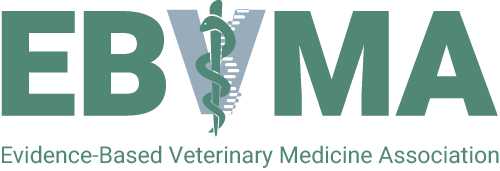- Home
- Resources
- EBVMA Podcast
- 2nd Podcast: EBVM Methods
2nd EBVMA Podcast: How to do EBVM with Dr. Robert Larson, Dr. Patrick Hemming, and Erik Fausak Recorded August 2016 Abstract The process of Evidence-Based Medicine (EBM) is divided into 5 phases:
The practice of evidence-based veterinary medicine (EBVM) starts with forming a clinical questions. Questions, like evidence, should be prioritized. Likewise, once the question is formed and the evidence is found, a critical eye should examine factors the reader understands, most clinicians are not statisticians, put emphasis on the methodology over the statistical method when evaluating quality. 1 Introduction to EBVM by Dr. Robert Larson Dr. Larson lead the discussion of incorporating EBVM into practice.
2 Discussion Key Points 2.1 VetSRev Dr. Hemming pointed out the value of a database that indexes only secondary research or system- atic reviews, VetSRev. Dr. Larson pointed out that as time progresses, the amount of systematic reviews that are populating this database are increasing significantly. Not only that, but Dr. Lar- son also mentioned that systematic reviews are constantly improving in quality, because despite being the best level of evidence, they are limited by their quality. 2.2 Alleviating Bias with Quality Research Dr. Hemming addressed another important issue that EBVM may alleviate. Many studies are funded by the companies trying to sell a product, can EBVM address this inherent bias in research? Dr. Larson stated that as the quality of these systematic reviews improve, it can alleviate the bias of interested funding sources. Dr. Larson also touched on the less measured existence of publication bias that anyone receiving grant money from any foundation (including government) have a pressure to publish positive results. The consensus was that some factors of publication bias can be alleviated with transparency and quality research. This topic has been compellingly discussed at the 2015 7th EBVMA Symposium. Dr. Larson mentioned that when conducting systematic reviews, drug manufacturers were often contacted for information that may not be complimentary or published, sometimes they may share information or sometimes they may not. Vet All Trials is an initiative to index all research being conducted whether published or not, whether positive results, or not. 2.3 How to Evaluate Literature Without Strong Statistical Knowledge or Background Dr. Hemming asked another key question that concerns many clinicians. Many studies that seem to have good information may often be discounted for statistical reasons (typically power), how can a non-statistician evaluate a study? Dr. Larson brought up two good points, as a clinician, a critical eye should be placed on what the clinician can evaluate, the trial methodology. Dr. Larson stated that in many cases the reader has to trust the effort of the statistician involved in the study and the peer reviewers, but the reader can evaluate the animals used in the study and how the study is conducted. Erik mentioned in Trisha Greenhalgh’s book, "How to Read a Paper" [1] , that typically only certain tests are used in clinical trials and when abnormal statistical methods are applied, it may raise eyebrows. Dr. Larson supported this with the caveat that in some cases, a different statistical test may need to be used to best evaluate the study. A different statistical test could be used for a unique type of a study. 2.4 Be Open Minded but Not Gullible Dr. Larson ended on this key note, "To be open minded is not to accept everything, being open minded means being willing to consider anything and when presented with enough evidence, to change their mind" 2.5 Guest Biographies • Bob L. Larson, DVM, PhD, ACT, ACAN, ACVPM 111B Mosier Hall, Manhattan, KS 66506 area of beef production medicine. In 2006 he returned to Kansas State University as the Coleman Chair of Food Animal Production Medicine. He is board certified by the American College of Theriogenologists, the American College of Animal Nutrition, and the American College of Veterinary Preventive Medicine – Epidemiology specialty. He has served a number of leadership roles including serving as president of the Academy of Veterinary Consultants and the Evidence Based Veterinary Medicine Association. Bob and his wife Laura (DVM ’92) have three daughters, Mariah (18 years), Karrin (15 years), and Annie (11 years). • Patrick Hemming, B.S., D.V.M. Attained his doctoral degree in 1976 from Colorado State University. Dr. Hemming instructs students in the theoretical and applied aspects of veterinary reproduction. He owns and operates Animal Reproductive Technologies, a beef cattle production medicine, nutrition, reproduction, and veterinary consulting service. Dr. Hemming operates Aristocrat Angus Ranch’s beef cattle reproduction services and has traveled extensively implementing feasibility studies for livestock projects. • Erik Fausak, MSLIS, CVT, RLAT Erik has always had an interest in the role of animals and humanity since studying Anthropology at Beloit College, WI. In 1999, Erik attended Bel-Rea Institute of Animal Technology and worked at Alameda East Veterinary Hospital in Denver and Fifth Avenue Veterinary Specialists in New York City. His interest took him to graduate school at City University of New York, Hunter College, where his thesis work focused on langur phylogeny and neonatal coat color. Erik then attended library school at Pratt Institute. Erik has been an active participant in the EBVMA and EBVM Network while teaching at Bel- Rea Institute of Animal Technology. Since then he has been an active proponent of incorporating evidence-based veterinary medicine in his curriculum and training his students to become research leads in evidence-based veterinary medicine. Currently his journal club has written two articles utilizing EBVM techniques. Erik enjoys camping, hiking, biking, and boating with his wife, 3 year old son,William, and 2 dogs. 2.6 Links and References Links • VetSRev References [1] T. Greenhalgh. How to read a paper : getting your bearings (deciding what the paper is about). BMJ, 315(7102):243–246, 7 1997. 2nd EBVMA Podcast.pdf |
